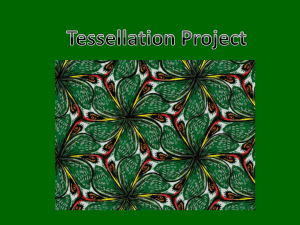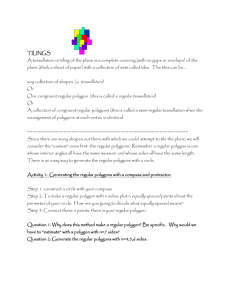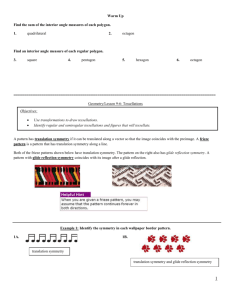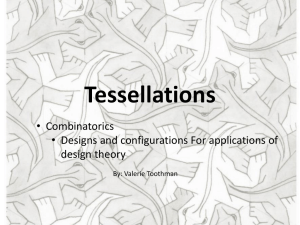Chapter 10 sec 6 - University of New Mexico
advertisement
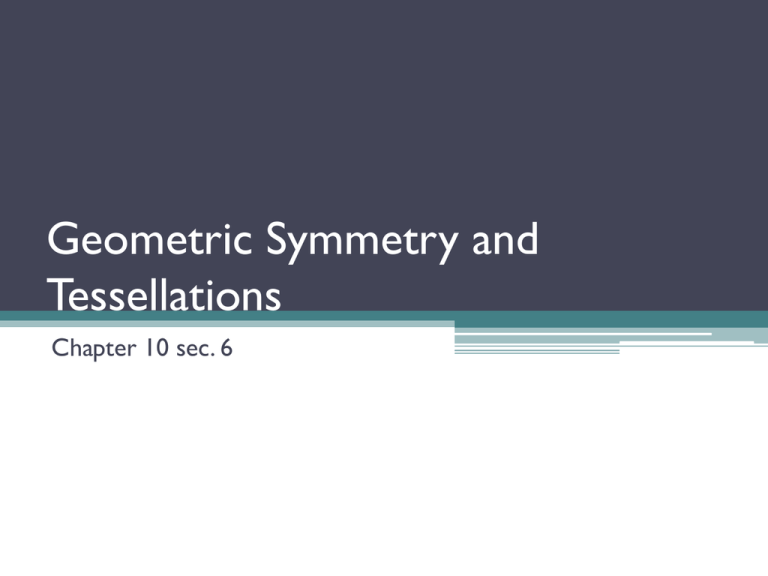
Geometric Symmetry and Tessellations Chapter 10 sec. 6 What is a polygon? • Is a simple, closed plane figure consisting only of line segments, called edges, such that no tow consecutive edges lie on the same line. It is regular if all its edges are the same length and all of its angles have the same measure. What types of shapes can you have for a polygon? Regular: sides are same length Nonregular polygon; sides are not the same length What about a circle? •Is it a polygon? •No, it is not made of line segments. What is symmetry? •Define it later. But here is something to think about. •In mathematics, we begin with an intuitive concept, and define it precisely so that we can measure it and calculate with it. Rigid Motion • A rigid motion is the action of taking a geometric object in the plane and moving it in some fashion to another position in the plane without changing its shape or size. 2 objects Arrowhead Star Example (a) (b) • The arrowhead has been flipped over and returned to its resting place. Property: ▫ Every rigid motion is essentially a reflection, a translation, a glide reflection, or a rotation. What does essentially really mean? • We are only interested in the beginning and ending positions of the object. Reflection • Is a rigid motion in which we move an object so that the ending position is a mirror image of the object in its starting position. Reflection example Axis of reflection Translation • Is a rigid motion in which we move a geometric object by sliding it along a line segment in the lane. The direction and length of the line segment completely determine the translation. Translate an object Translation A vector B A’ B’ Glide reflection •Is a rigid motion formed by performing a translation (the glide) followed by a reflection. Steps to the Glide reflection • 1. Place a copy of the translation vector at some point A, on the object. A B Axis of reflection • 2. Slide the object along the translation vector so that the point A coincides with the tip of the translation vector. A B Axis of reflection A’ B’ • 3. Reflect the object about the axis of reflection to get the final object. C C” A B A” B” This is the final effect the glide reflection has in moving the original polygon. A B A” B” Rotation • We perform a rotation by first selecting a point, called the center of the rotation, and them while holding this point fixed, we rotate the plane about this point through an angle called the angle of rotation. Example • Say you have a piece of paper. If you stick a pin in the plane at the center of rotation and then rotate the plane, the plane will turn about the pin, and all points in the plane will move except the point where the pin is placed. A 90 degrees A’ A Symmetry • A symmetry of a geometric object is rigid motion such that the beginning position and the ending position of the object by the motion are exactly the same. Symmetry in Nature • 2 professors at the University of New Mexico, Randy Thornhill and Steven Gangestad, have found that female scorpion flies are attracted to males with symmetrical wings. • Biologist believe that animals with a higher degree of symmetry have greater genetic diversity, which enables them to withstand environmental stress better and makes them more resistant to parasites. Lower symmetry goes hand in hand with lower survival rates and fewer offspring. Tessellations • (or tiling) of the plane is a pattern made up entirely of polygons that completely covers the plane. The pattern must have no holes or gaps, and polygons cannot overlap except at their edges. Def. • Tessellation The root of tessellation is, tessera, the old Ionic (Greek) root for four. Tessera is the name of the square chips of stone or glass that are used to form a mosaic. Tessela is the dimunitive form, and is used to describe smaller tessera. Tiles, bricks and larger similar items were called testa, which is preserved in the name for the hard outer shell of seeds. The completed project, then, became a tessellation. Regular Tessellation • Consist of regular polygons of the same size and shape such that all vertices of the polygons touch other polygons only at their vertices. Some tessellation patterns n-sided polygon • Each interior angle has measure ( n 2 ) x180 n . • We can use this to determine which other regular polygons tessellate the plane. What does that mean? • Means that the angle sum around a vertex in a tessellation must add up to 360 . 120 120 120 Regular Tessellation Is there a tessellation of the plane using pentagon? •How many sides does a pentagon have? •5 •Let’s use the formula 5 2 x180 5 540 108 5 •We will not have enough pentagons to completely surround the vertex. • There is no regular tessellation of the plane using pentagons. 108 Can you find the nonregular tessellations? • Is it possible to find a nonregular tessellation with using a square and triangle? • Yes • Is it possible to find a nonregular tessellation with using an octagon? • yes

